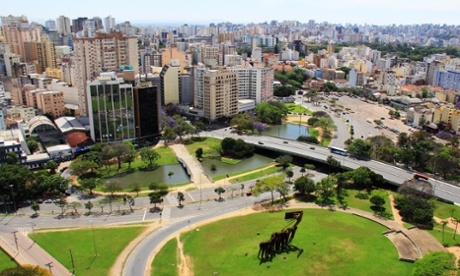
The week’s best city stories explore “zombie” streetcars in San Francisco, bus-stop stickers in Porto Alegre and the restoration of deserted Rust Belt train station terminals.
We’d love to hear your responses to these stories and any others you’ve read recently, both at Guardian Cities and elsewhere: share your thoughts in the comments below.
Better Brazilian bus stops
Maddeningly, Porto Alegre’s bus stops tend to lack proper signage and information. Now a group of frustrated residents have responded creatively to the problem: they have started an initiative called Que Ônibus Passa Aqui? (“Which Bus Stops Here?”), in which they put stickers on the bus stops on which users can write information about which buses stop there – for the benefit of everyone.
As Pop-Up City describes, the collaborative idea has now spread beyond Porto Alegre to 20 other cities, as well as attracting the participation of a graphic design company to mass-produce stickers. It may not be a permanent solution, but it shows how citizens can come together to improve their cities in a fun and creative way.
‘Zombie’ streetcars
On San Francisco’s southern waterfront lies a yard for derelict streetcars awaiting their fate: deconstruction, or restoration. Dating from the 1940s and 1950s, some of the carriages are still covered in original signs about how to buy tickets or admonishments about good behaviour; others are completely taken over by graffiti. This photo gallery of the streetcars is a visual treat, and reveals the history of this well-loved form of public transport in San Francisco. Many of the streetcars do find use again, and instead of being reimagined or reappropriated, actually return to their former glory as functional transit on the city streets.
Terminal condition
In most capital cities, you’d be hard pressed to imagine the bustling main train stations as vacant, ghostly structures. But in Rust Belt cities like Buffalo, Detroit and Cincinnati, grand urban train stations have been deserted for decades, attracting dust and vandalism as the cities have emptied of people or changed their transport patterns.
Nevertheless, as Belt Mag discusses, there is new momentum to revive these stations, with projects pushed forward by non-profit organisations such as Buffalo’s Central Terminal Restoration Corporation. A team of volunteers clean and look after Buffalo’s station; the concourse is being used as a temporary events space; and funding is slowly being gathered to repair the building. The project demonstrates the grassroots commitment to protect local heritage. The final use of the restored building, however, remains unsure. Though it could in theory still function as a train station, no trains will actually be arriving, so lots of other ideas are on the cards: from a casino or housing complex to an unusual football stadium.
The arrogance of space
By photographing and analysing road junctions in Paris, Calais and Tokyo, Copenhagenize has produced illuminating graphics on exactly how much space of our cities is dominated by cars – and what relatively little infrastructure is dedicated to pedestrians and cyclists. Only in Tokyo, where larger road crossings are prevalent, do we see the humble pedestrian rebalancing the ratio.
Mobility in an earthquake
Disaster relief in cities could be more effective if it could predict where exactly people will go in the event of an earthquake. As Fast Co Exist explains, one researcher claims to have done just this: by tracking mobile data in Tokyo on the day of the devastating 2011 earthquake, Xuan Song has mapped the movements of people after the disaster struck. The result is a pulsing, glowing visualisation that certainly looks pretty – but to what extent can a reliable model for prediction be formed from one event?
Crashes? There’s an app for that
A new app called Bikeshield promises to alert drivers to nearby or approaching cyclists and motorcyclists before they can even be seen. The idea is to avoid crashes and collisions and improve road safety. What could be better? Unfortunately, as CityMetric reports, there is a drawback: for the alerts to work, both car driver and cyclist need to have it installed. Perhaps one day this sort of system will be widespread, but for now, drivers will just have to rely on that age-old trick: driving carefully.
Does your city boast a community initiative to beat Porto Alegre’s? How could revived Rust Belt stations be used? Share your thoughts in the comments below
• What’s your city’s best idea? Champion it in the 2014 World Cities Day Challenge

